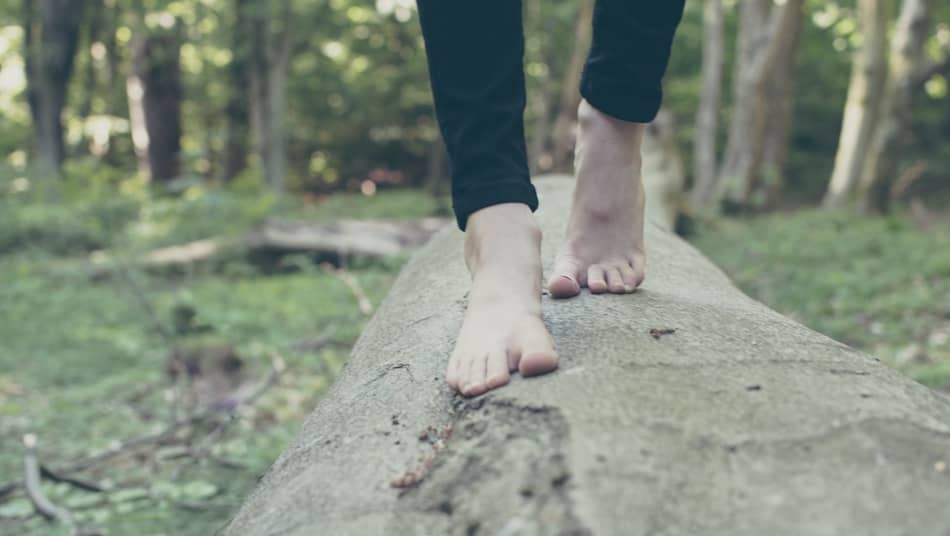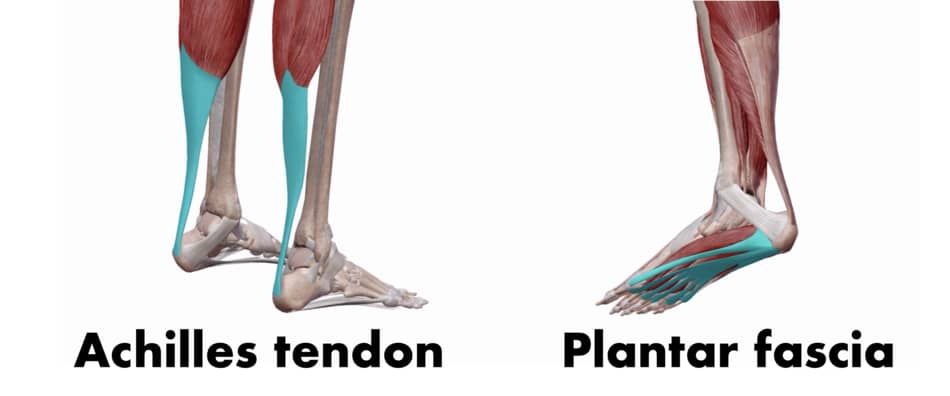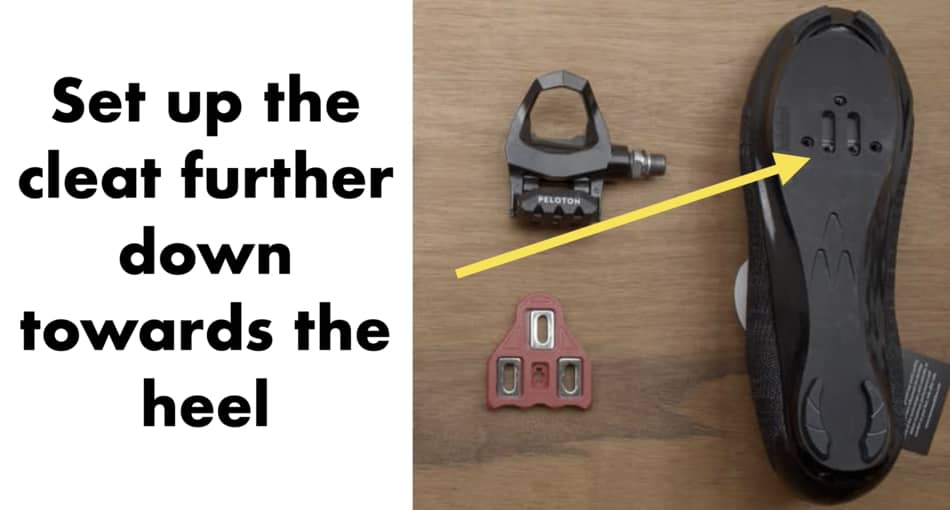Cycling is one of the least possible ways to cause foot pain and plantar fasciitis. However, many people still have this problem. In this article I will clarify if peloton can cause plantar fasciitis, and if so, what can you do to help.
As a whole, the peloton bike doesn’t cause plantar fasciitis or foot pain because it is low-impact movement and doesn’t require heel strikes. However, a sudden increase in training intensity or training volume can lead to tightness in the calves, which can contribute to pain in the foot.
But there are other factors that play a role in why your feet can hurt on a peloton like the structure of the foot, bike position, cleats position, shoe size, and more.

Peloton Bike and Foot Pain
In general, there are three common causes of plantar fasciitis which include calf muscle tightness, foot biomechanics, and excessive activities that put pressure on the heels.
NOTE: Before we dive in if you have plantar fasciitis or other foot-related problems I strongly recommend checking with your physical therapist.
What is Plantar Fasciitis?
Overall, plantar fasciitis is the inflammation of the fibrous tissue that stabilizes the arch of the foot, as well as provides shock absorption when the foot hits the ground. Plantar fasciitis is most common in runners, but some cyclists do experience this problem, too.
The plantar fascia is often described as an extension of the Achilles tendon into the foot.

This means that whatever is affecting the function and range of motion in the Achilles tendon and muscles surrounding it will have an impact downstream in the plantar fascia.
In other words, most of the muscles that control our feet are not in the feet. They are in the calves.
There are a few reasons for plantar fasciitis to occur after riding on the peloton:
- Intrinsic factors – Intrinsic factors include foot structure, which dictates the way you walk. Whenever that’s overpronation from flat feet, or supination from a high arch. Anything that changes the walking pattern can affect the way weight is distributed and cause micro-tears in the plantar fascia.
- Extrinsic factors – Entrinsic factors are all related to overuse and stress on the plantar fascia. These inlude high-impact and plyometric exercises, incorrect training and inadequate footwear.
As you can see, there are several factors that can contribute to foot pain. However, when it comes to cycling, in most cases it’s overuse stress on the plantar fascia.
Can You Get Plantar Fasciitis From The Peloton?
As a whole, you can get plantar fasciitis from riding the peloton after a sudden increase in distance, intensity, duration, or frequency of your training. Also, wearing inappropriate footwear with not enough cushioned surfaces can lead to foot pain.
The first reason is more common for cyclists because riding the bike with a high training volume each week leads to tension in the gastrocnemius-soleus complex.
This tension often transitions down towards the foot and changes the biomechanics.
Studies have shown that “tight gastrocnemius, soleus, and/or other posterior leg muscles have been commonly found in patients with this plantar fasciitis. It is thought that these tight muscles can change normal biomechanics” (Buchanan 2021).
In other words, if your leg muscles are brutally tight, this will restrict your range of motion, translate into incorrect movement mechanics, and can cause micro-tear in the fascia.
Can Peloton Worsen Plantar Fasciitis?
In short, the peloton can worsen plantar fasciitis only if you spend too much time on the bike or fail to reduce muscle tension after each workout. One of the easiest ways to reduce foot pain is to spend an extra 5 to 10 minutes stretching or foam roll.
Does stretching help with plantar fasciitis? As a general rule, stretching does help with plantar fasciitis because it helps to release the muscle tension in the lower leg, improve the range of motion and reduce stress on the plantar fascia. You can also massage the bottom of the foot using foam rollers or your hands.
I always recommend to my clients who experience any type of foot pain from peloton is to divide their workouts into three sections:
- Warm up ride – Before you hop on the bike to do your main ride, start from 5 to 10 minutes warm-up ride that will get your muscles working. This helps with muscle perfusion, loosen up the tendons and ligamnets, and prepares them for the stretch.
- Stretch and foam roll – Get off the bike and spend some quality time on the exercise mat. I always strethc my calves, quadriceps, hamstrings, and hips. I also like to add some foam rolling if I feel there is more tension than it should be.
- Start your ride – Now you’re ready for your ride. Once you spend some time on the mat you can get back on the bike and go for the main thing.
Also, if you have currently any foot-related pain right now, I would recommend spending at least one day of the week where you mobilize your full body. This includes stretching and foam rolling but for longer.
You can learn more about “best peloton stretch classes” in my article here.
I find that foam rolling your calves, quads, and hamstrings on weekly basis not only gives enough range of motion and improves the overall walking position, but also helps to reduce muscle tension and prevents foot pain.
Another thing that can aggravate plantar fasciitis is your cycling shoe.
Plantar Fasciitis and Peloton Shoes
In general, an overly tight pair of cycling shoes can aggravate plantar fasciitis by compressing the metatarsal arch. This leads to changes in foot mechanics like excessive pronation or supination and puts abnormal pressure on the fascia band, which over time can lead to strain and microtears.
I had this problem for years when I used footwear that was too tight. Because I have large feet, I was more concerned about how my shoe looked, instead of how they felt.
It’s better to wear cycling shoes that have slightly more space rather than wear a pair that is too tight and can cause foot cramps, toe pain, and numbness.
I used to wear shoes that were too tight because I thought they didn’t look good. Big mistake.
Learn more: Click here to learn more about how to get a “peloton healthcare discount“.
Plantar Fasciitis and Cleat Position
Another factor that affects plantar fasciitis is using cycling shoes with incorrect cleat positions. Getting your cleats set up correctly helps avoid common injuries, including foot pain.

Place your cleats in line with the ball of your foot. If you’re using the peloton shoes this means moving the cleats as far back towards the heel as you can. This will allow to redistribute the force and put less pressure on the fascia band.
Placing cleats too far forward increases the amount of toe-down pressure, which affects the distribution of the force on the feet, instead of the hips.
The last thing you can consider is to get shoe orthotics.
Plantar Fasciitis and Shoe Inserts
As a whole, using the shoe inserts during peloton rides is an effective way to realign the foot, engage the arches, and reduce excessive pronation or supination. Keeping the foot in a neutral position reduces the stress on the plantar fascia.
Pronation happens when the feet roll inward too much. This puts extra pressure on the muscles and other connective tissues of the foot.
Wearing shoe inserts helps to maintain stability in the arch and keeps the foot in a subtalar neutral position.
Learn more: Click here to learn more about “best peloton postpartum classes“.
Conclusion
As you can see, plantar fasciitis is not really a cycling issue but more of a muscle tension and footwear problem.
Spending extra time to reduce muscle tension before and after the rides can be all that is needed to reduce the pain.
Alternatively, you can try to change the cleat position and make sure your cycling footwear is sized correctly.
